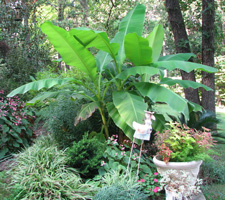Resource Library
Plant of the Week: Hardy Banana
The University of Arkansas System Division of Agriculture does not promote, support or recommend plants featured in "Plant of the Week." Please consult your local Extension office for plants suitable for your region.
Plant of the Week
Hardy Banana
Latin: Musa basjoo

The tropical look is in, and gardeners have become well versed in using elephant ears, bananas and other large-leafed tropicals to create the look. But, after a time, dealing with lifting and storing over winter all of those frost-tender plants get to be a bit of a drag.
Now, it’s a bit easier because you can plant the winter hardy banana (Musa basjoo) and simplify the task.
The hardy banana is the most cold-hardy banana, capable of surviving winter temperatures of minus 5 degrees without protection or minus 20 degrees with heavy wintertime mulch. It’s native to China but migrated throughout Asia during ancient times.
Bananas are perennial herbs with the true stems located below ground where they form a coarse underground rhizome or, for non-running bananas, a structure called a pseudobulb. M. basjoo is a rhizomatous banana forming multiple trunks as the size of the colony expands.
Banana trunks (called pseudostems), though they may approach the size of a small tree in some species, are formed from the whorled and tightly rolled leaf bases. The hardy banana produces pseudostems to 6 feet tall with the large, erect leaves making the plant seem twice as tall. Trunks 4 to 5 inches across are common. My 2-year-old plant has three trunks; a 6-year-old clump has more than a dozen stems forming a colony about 6 feet across.
The leaves on the hardy banana are typical for the species and reach 4 to 6 feet long and a foot wide. The upper surface is a medium green with the lower surface somewhat lighter, but not waxy. In a windy site, the leaves will be ripped and shredded; in a more protected site, they will be entire and oar-shaped.
Bananas need 10 to 12 months of frost-free conditions to flower and set fruit, so in temperate climates where the plant freezes to the ground each winter, you’ll probably never see blooms. In milder parts of the country, flowers might be seen in its fifth year. Female flowers are produced first and don’t overlap with the reddish-brown to purple male flowers. For the three to five angled, 3-inch long bananas filled with numerous black seeds to form plants must be manipulated artificially to ensure pollination. But, should you get fruit, they are inedible.
Two main forms are reportedly available in the trade; the “normal” form listed by European nurserymen as ‘Fuji-Yama’ (a made-up name with no connection to Mt. Fuji) or ‘Sakhalin,’ a selection said to grow on the Russian island north of Japan. It’s reportedly more cold hardy than the “normal” form.
Hardy banana is perfectly hardy through most parts of the South and can be grown throughout much of the Midwest. Reports from gardeners in Ohio, Iowa and other zone 5 locations report it’s perfectly winter hardy with them. In colder areas, a thick mulch of leaves might be beneficial.
Plants are easy to grow in average soil in full sun or part shade. Bananas require a lot of water and will grow larger if fertilized each spring before new growth starts. Division of offsets should be done just as plants begin to break dormancy in the spring. Planting in an area protected from wind will reduce leaf shredding.
By: Gerald Klingaman, retired
Extension Horticulturist - Ornamentals
Extension News - September 7, 2007
The University of Arkansas System Division of Agriculture does not maintain lists of retail outlets where these plants can be purchased. Please check your local nursery or other retail outlets to ask about the availability of these plants for your growing area.